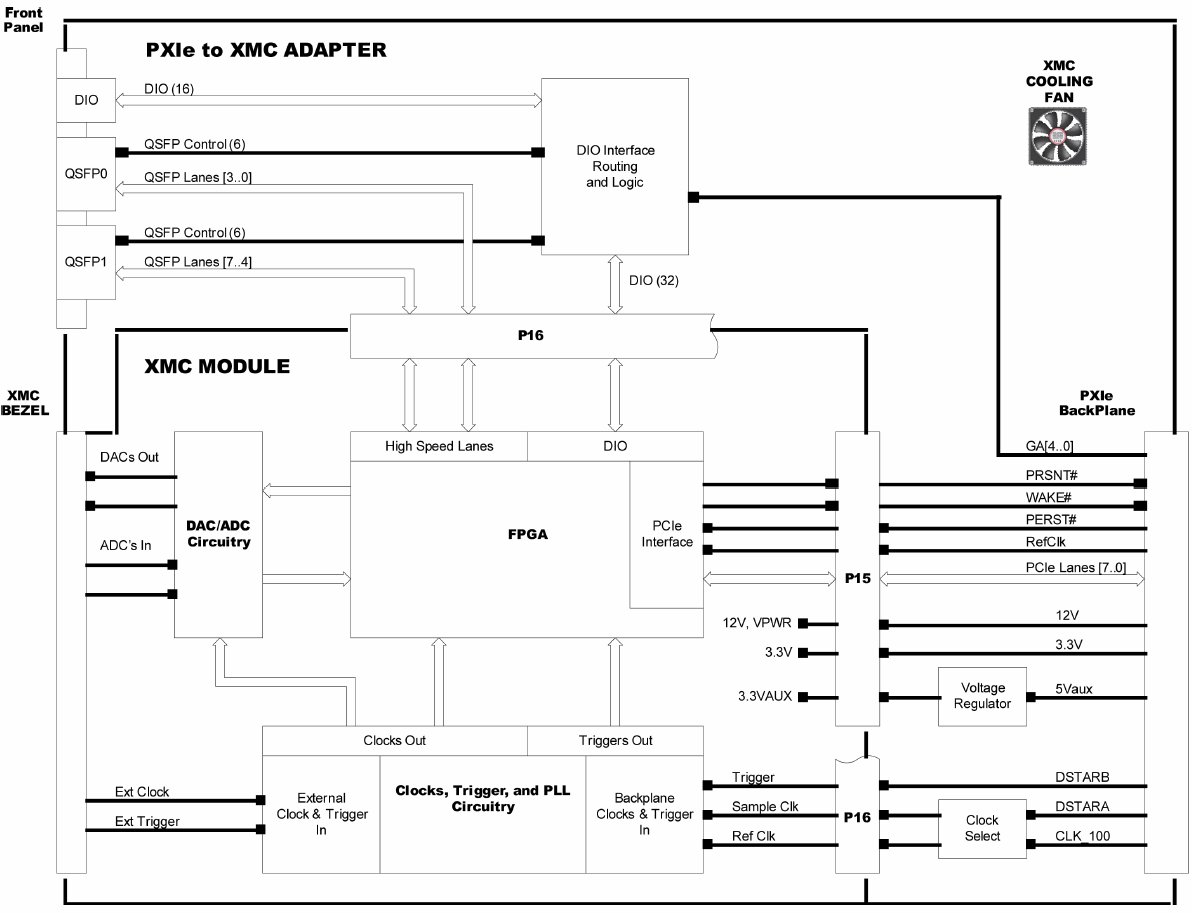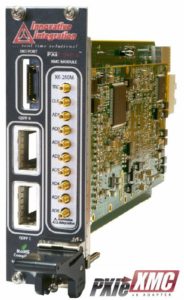Building a High Performance Data Acquisition system in a PXIe chassis using XMC modules
figure 1
When designing a high performance data acquisition system, a significant decision is what chassis form factor to use. A rackmount 19 inch chassis comes to mind as a good generic solution, and the PXIe version seems like a good candidate as it is standardized, reasonably priced, and available from multiple vendors. The only significant concern is that native PXI/PXIe modules are generally aimed at the testing market, which means they tend to have lower throughput, with less processing power than needed in high performance data acquisition systems.
This concern can be addressed by XMC modules powered by Xilinx UltraScale FPGAs that provide a universe of high performance data acquisition functions, featuring higher sample rates, and greater processing power with the on board FPGA’s, than typical PXI/PXIe modules. An XMC module can be incorporated into a PXIe chassis using an adapter which plugs into the chassis and is a carrier for the module.
PXIe to XMC Adapter
The Adapter has the normal mechanical characteristics of a PXIe module, plugging into the backplane, presenting a front panel for I/O connections, and serving as a carrier for an XMC module (figure 1). In this case, the Adapter is the ISI LLC “PXIe XMC x8 Lane Adapter” (www.isipkg.com/solutions/sensor-processing.) A block diagram of the Adapter with an XMC Module installed is shown in figure 2.
The basic function of the Adapter is to provide:
- A mechanical site for the XMC: J15 and J16 connectors to mate with the XMC P15 and P16 connectors, and a front panel that accommodates the XMC Bezel.
- Power from the PXIe backplane: 12V for XMC VPWR, 3.3V for XMC 3.3V, and PXIe 5VAUX.
- The 5VAUX supplies a 3.3V regulator that supplies XMC 3.3VAUX. PCIe Interface to the PXIe backplane: PRSNT#, WAKE#, PCIe REFCLK, PCIe PERST#, and up to 8 PCIe Lanes. These signals from the XMC correspond exactly to signals on the PXIe backplane, so they are passed through by the Adapter.
- Geographic Address information: the GA lines from the backplane are routed to digital I/O lines (DIO) provided by the XMC Module at P16.
Additional functions provided by the Adapter:
- Clock signals from the backplane: two clocks may be used from the PXIe backplane. A Clock Select circuit allows either DSTARA or CLK_100 to be selected for use as the sample rate or the PLL reference input of the XMC clock generation circuits. If the XMC Module is not equipped to use a clock at P16, its front bezel clock input can be used in the standard way.
- Trigger signal from the backplane: the DSTARB signal from the backplane may be used as a trigger. If the XMC Module is not equipped to use a trigger at P16, its front bezel trigger input can be used in the standard way.
Block Diagram
The Block Diagram shows additional functions on the front panel that are available for XMC Modules that have the appropriate high speed serial lanes and digital I/O signals available from its FPGA. These functions require additional front panel space, so this particular Adapter consumes two slot spaces. The two slot width of the Adapter allows a cooling fan that directs air to the XMC FPGA, as high performance XMCs can require extra air flow.
Two QSFP ports directly connected to the FPGA are provided to allow high speed communication with other parts of the system without burdening the PXIe system processor. Each QSFP has 4 high speed serial lanes, and 6 DIO lines for the standard QSFP control interface (the LP_MODE is strapped according to system requirements).
When “passive” metallic cables are used, the QSFP control lines are not used.
The DIO port exposes 16 digital I/O signals from the FPGA for the miscellaneous external control and status requirements of the system.
Conclusion
PXIe to XMC adapter adds a rich portfolio of cutting edge Xilinx UltraScale FPGA DAQ XMC modules and tools into the PXIe eco-system allowing customers to leverage COTS for high performance applications.

figure 2 – Block Diagram of Innovative Integration PXIe to XMC Adapter with XMC Module installed.







